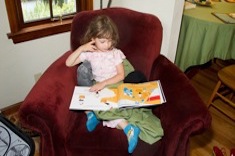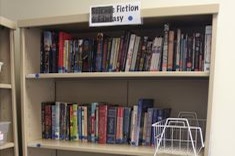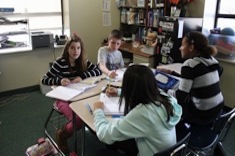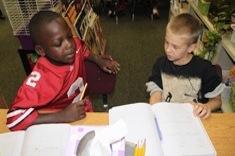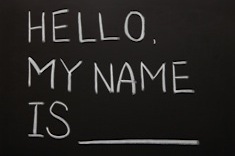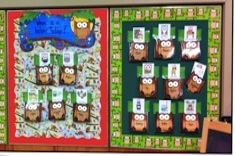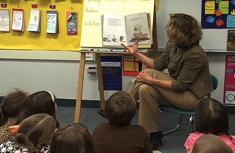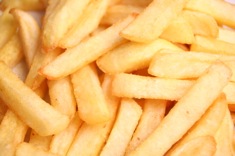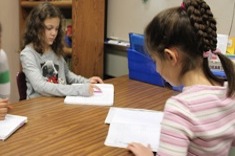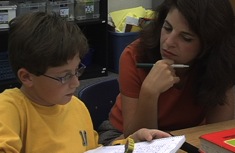Articles
Here is where you’ll find all the latest print features from our contributors. If you’d like to browse specifically by grade level, topic, or contributor, you can use the links in the right sidebar.
Latest Content
Inscribe It! (Home is Where the Books Are Series)
Some of the most treasured notes for many of us are the inscriptions in books that are gifts from others. Meghan Rose shares why inscribed books have lasting value for families.
Weaving Word Study into Writing Workshop in 5th Grade
Maria Caplin describes how she integrates word study with intermediate students in writing workshops.
Vocabulary and iPhones: A Four-Step Process for Independent Student Word Learning
Bryce Bennett develops a four-step process to help high school students use their smartphones to master difficult vocabulary while reading.
Student-Selected Vocabulary in Middle School
Katie Doherty shares many ways to make vocabulary learning fun in middle school, beginning with students working together to select words to study each week.
Curating the Classroom and School Library
As classroom budgets get tighter, teachers rely more and more on school libraries for books. Erin Ocon describes how she has changed the way she matches books and readers in her middle school classroom, depending more on school library resources and helping her middle school students navigate them.
The Power of Read-Aloud Notebooks
Karen Terlecky shares the process of launching and sustaining read-aloud notebooks with fifth graders.
From “Show Me the Lessons” to Sustainable Planning (Part 4 of the Opinion/Argument Writing Series)
This is the final installment in Heather Rader's series on argument and opinion writing in the intermediate grades.
Peer Conferring: The Release Phase
Amanda Adrian concludes her series on peer conferring, analyzing the value of students working on their own after instruction and practice.
Looking for the Open Door
Midyear is a wonderful time for taking conferences to the next level, now that you know your students well and they trust you. Beth Lawson gently challenges a young writer in her fourth-grade classroom to reach his full potential.
My Name Is Not Julie
Ellie Gilbert is deeply moved when her high school student connects to a text in a startling way. It’s one of those magic moments that keeps teachers coming back to classrooms, but is nearly impossible to share with others.
Comic Books and Mini Caped Crusaders for the Youngest Readers (Home is Where the Books Are Series)
Meghan Rose gives a mom’s perspective on comics for young children in this booklist. This is from our new series, Home is Where the Books Are, on literacy in the home from birth to age 5.
Touchy Topics for Opinion/Argumentative Writing
When students take a stand in writing, they will almost inevitably bring up touchy topics. Heather Rader considers the challenge in part 3 of her opinion/argumentative writing series.
A Graphic Novels Unit in 5th Grade
Katherine Sokolowski designs a graphic novels unit for her fifth graders, and is surprised by how much the genre delights them.
Understanding Adolescent Readers: A Podcast with Penny Kittle
In this podcast, Penny Kittle chats with Franki Sibberson about how to inspire a passion for reading in adolescents. A full transcript is available below the player.
Building Peer Conferring Skills in the Primary Grades
Ann Marie Corgill questions whether her second graders are ready for peer response. She finds that with some guidance and construction of anchor charts together, the answer is a resounding yes.
Thank You For Arguing
In the second installment of our teaching argument/opinion writing series, Heather Rader uses a continuum dialogue and modeled writing with intermediate students.
Classroom Jobs Build Community
Keri Archer describes her process of creating a jobs list for her kindergartners, as well as how she has adapted the tasks based on the evolving class community.
It’s Not About the Tool — It’s About the Learning
Maria Caplin explains step by step how she integrated the use of iPods into her writing workshop, helping students use them to record notes and create persuasive texts.
Previewing and Picture Walks with Fiction Texts
Clare Landrigan and Tammy Mulligan provide previewing how-to advice for grades K-2 teachers.
Eyes on the Fries: Just-Right Books and Reading Peer Pressure in Middle School
Gretchen Taylor addresses the issue of "peer-pressured reading" in middle school reading workshops, with a practical example of how she helped her students move beyond the fad book of the moment to more thoughtful previewing and independent reading choices.
Bully Literacy
Heather Rader shares texts for building understanding about bullies.
Two Teachers and One Kindergartner
Principal Jennifer Schwanke looks at the challenging issue of retention and the power of teamwork.
Fun in January: A Mock Caldecott Unit
Katherine Sokolowski discovers a seven-day Mock Caldecott unit is a fun way to build a reading community by predicting the winners, and Skyping with another class to share results.
New Year Goals (Part 2)
Choice Literacy contributors share their New Year goals. This is the second installment in a two-part series.
New Year Goals
At the start of the new year, Choice Literacy contributors reflect on their most important goals for January. This is the first installment in a two-part series.
The Writing Process . . . and Processes
Ruth Ayres considers elements of the writing process that are common to all, and which ones vary according to the needs, interests, and quirks of writers.
I Love a Good Argument
As Heather Rader works with teachers and teams on opinion/argumentative writing, she’s considering the anatomy of an argument and engaging ways to teach it.
Word Count
Ruth Ayres finds that keeping a word count is a potent way to increase writing quality over time.
Just Write More
Aimee Buckner has tips for ways to focus lessons that will help students produce more writing.
Happy Holidays from Choice Literacy and Pete the Cat
Wishing you and yours a totally groovy Pete the Cat holiday season.
Browse Content By
Type
Category
- Assessment Tools
- Big Fresh Archives
- Booklists
- Choice Numeracy
- Classroom Design
- Common Core
- Community Building
- Conferring
- Content Literacy
- Digital Literacy
- English Language Learners
- Equity
- Family Relations
- Free Samples
- Guiding Groups
- Leadership
- Literacy Coaches
- Mentor Texts
- Minilessons
- New Teacher Mentors
- Podcasts
- Poetry
- Quote Collections
- Reading Strategies
- Self Care
- Struggling and Striving Learners
- Talking and Listening
- Teacher Study Groups
- Teaching Reading
- Teaching Writing
- Word Study and Vocabulary
Author
- Melissa Quimby
- Nawal Qarooni
- Gwen Blumberg
- Julie Cox
- The Lead Learners
- Hannah Tills
- Josie Stewart
- Ruth Metcalfe
- Mallory Messenger
- Becca Burk
- Jodie Bailey
- Vivian Chen
- Mary Brower
- Tiffany Abbott Fuller
- Stephanie Affinito
- Ruth Ayres
- Leigh Anne Eck
- Heather Fisher
- Shari Frost
- Julie Johnson
- Suzy Kaback
- Gigi McAllister
- Shirl McPhillips
- Melanie Meehan
- Cathy Mere
- Debbie Miller
- Tara Barnett and Kate Mills
- Tammy Mulligan
- Dana Murphy
- Bitsy Parks
- David Pittman
- Brenda Power
- Heather Rader
- Matt Renwick
- Mandy Robek
- Christy Rush-Levine
- Gretchen Schroeder
- Jen Schwanke
- Brian Sepe
- Katherine Sokolowski
- Stella Villalba
- Jennifer Vincent
Grade Level
Choice Literacy Membership
Articles
Get full access to all Choice Literacy article content
Videos
Get full access to all Choice Literacy video content
Courses
Access Choice Literacy course curriculum and training

